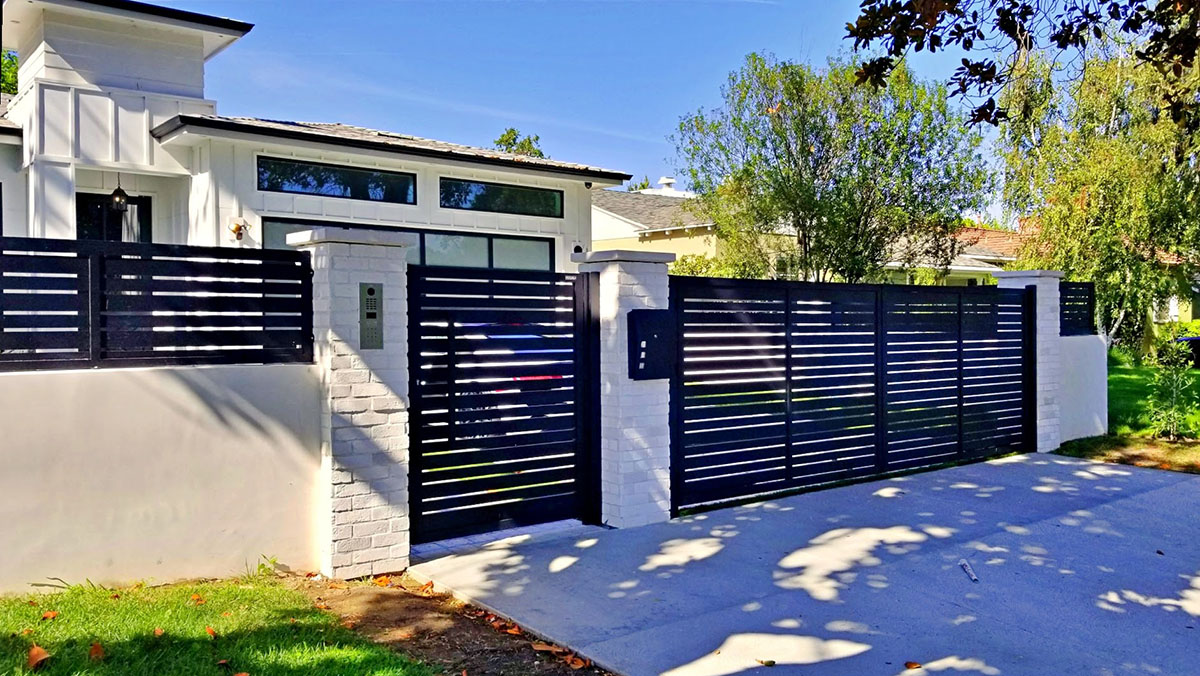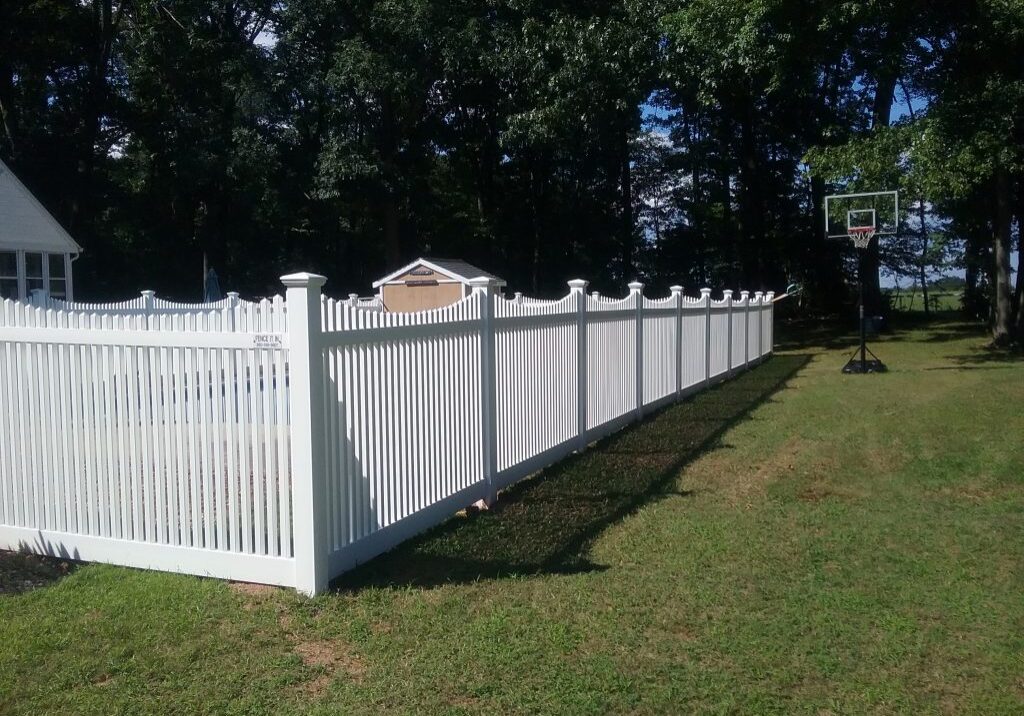All Categories
Featured
When picking a fence for your home, it's necessary to consider factors like cost, sturdiness, maintenance, and aesthetic charm. 3 of the most prominent products for commercial and property fencings are plastic, timber, and light weight aluminum. Each deals unique advantages and some drawbacks, making it crucial to assess your requirements prior to choosing. Below, we compare the benefits and drawbacks of these materials to aid guide your selection.
Timber Fence. Pros:
![]()
All-natural Visual: Timber fences are recognized for their traditional, natural appearance. They can quickly blend into a lot of landscapes and boost the charm of your home or business. Whether you're intending for a rustic look or a more polished finish, timber can be personalized with paint, stain, or sealant. Modification: Timber is among the most functional materials, permitting a wide range of designs, such as picket fencings, privacy fencings, and ranch-style enclosures. It's very easy to change the design to fit the particular needs of your home. Economical: Typically, timber fencings come with a lower first expense compared to plastic or light weight aluminum, making them an affordable choice for those on a budget plan. Cons:
Maintenance Requirements: Timber fences call for routine upkeep to maintain their appeal and performance. This includes staining or paint to shield against rot, termites, and weather condition damages. Without proper care, timber can break down over time. Shorter Life Expectancy: Contrasted to vinyl or light weight aluminum, wood fencings often tend to have a shorter life-span, particularly in areas with severe weather. Severe problems, such as hefty rain, moisture, or snow, can cause wood to weaken quicker. Prone to Damage: Wood fences are prone to harm from parasites, including termites, in addition to natural wear from weather condition. They might additionally warp or crack otherwise correctly kept. Plastic Secure fencing. Pros:
Reduced Maintenance: Among the primary advantages of vinyl fences is that they need marginal maintenance. Unlike wood, plastic does not require to be repainted, sealed, or discolored. It's immune to fading, staining, and fracturing, which saves money and time on maintenance. Resilience: Vinyl is recognized for its capacity to hold up against extreme climate condition without weakening. It's resistant to pests like termites, and its resistance to wetness and UV rays guarantees it continues to be looking excellent for years. Long-Lasting: A plastic fence can last as much as three decades or even more, making it an excellent long-term financial investment. Many manufacturers supply warranties, even more boosting its worth. Variety of Styles: Plastic fencings are offered in numerous colors and styles, consisting of those that mimic wood. You can choose from personal privacy, picket, or decorative styles, giving flexibility to match your home or service. Disadvantages:
![]()
Higher Upfront Price: Plastic fencings have a tendency to have a higher initial expense than timber. While the lasting cost savings on maintenance are substantial, the upfront investment might be a deterrent for some home owners. Restricted Modification: Plastic fences been available in standard layouts, and while styles and colors are different, you might not have as much flexibility for modification compared to wood. Breaking in Cold Climates: While plastic is sturdy, in extremely cold environments, it can come to be weak and split upon effect, which can be problematic in locations with severe wintertimes. Aluminum Fence. Pros:
Low Maintenance: Aluminum fences are known for their low-maintenance demands. Unlike timber, light weight aluminum doesn't corrosion or corrode, and it does not require to be painted or sealed. This makes it a terrific option for those who want a problem-free option. Toughness and Toughness: Aluminum is a durable material that stands well to harsh weather. It's an outstanding selection for seaside locations where deep sea corrosion is a worry, as it's resistant to rust. Aesthetic Charm: Aluminum fencings offer a clean, stylish look, typically used for attractive objectives. They're readily available in different designs, consisting of decorative styles, and can add a high-end feel to your building. Protection: Aluminum fences are long lasting and deal excellent protection, especially when mounted with locks or entrances. Their strong building supplies a trusted barrier versus unwanted entry. Disadvantages:
![]()
Greater First Cost: Light weight aluminum fences have a tendency to be extra costly than wood, especially if you select attractive designs. The ahead of time expense may be too high for some. Much Less Personal privacy: Light weight aluminum fencings normally have bigger voids in between the slats, which means they supply much less privacy than wood or vinyl fences. Aluminum may not be the best alternative if seclusion is a priority. Denting Issues: While aluminum is rust-resistant, it is prone to nicking or bending if struck with pressure. A lorry crash or heavy effect can create lasting damages to the fencing. Which Fence Product is Right for You? Choosing the best fencing depends upon several variables, including your budget plan, design preferences, upkeep capability, and the environment in which you live. If you desire a natural look and are planned for normal maintenance, wood may be the right choice. Plastic is an excellent choice if low-maintenance and long life are your priorities. For those that favor a sleek, contemporary look with very little treatment, light weight aluminum provides a long-lasting, secure service.
Inevitably, each secure fencing material has its advantages and disadvantages, so it is necessary to assess what matters most for your details requirements. Consider the environment, the degree of personal privacy you call for, and just how much upkeep you agree to devote to, and you'll locate the perfect fencing for your property.
Timber Fence. Pros:

All-natural Visual: Timber fences are recognized for their traditional, natural appearance. They can quickly blend into a lot of landscapes and boost the charm of your home or business. Whether you're intending for a rustic look or a more polished finish, timber can be personalized with paint, stain, or sealant. Modification: Timber is among the most functional materials, permitting a wide range of designs, such as picket fencings, privacy fencings, and ranch-style enclosures. It's very easy to change the design to fit the particular needs of your home. Economical: Typically, timber fencings come with a lower first expense compared to plastic or light weight aluminum, making them an affordable choice for those on a budget plan. Cons:
Maintenance Requirements: Timber fences call for routine upkeep to maintain their appeal and performance. This includes staining or paint to shield against rot, termites, and weather condition damages. Without proper care, timber can break down over time. Shorter Life Expectancy: Contrasted to vinyl or light weight aluminum, wood fencings often tend to have a shorter life-span, particularly in areas with severe weather. Severe problems, such as hefty rain, moisture, or snow, can cause wood to weaken quicker. Prone to Damage: Wood fences are prone to harm from parasites, including termites, in addition to natural wear from weather condition. They might additionally warp or crack otherwise correctly kept. Plastic Secure fencing. Pros:
Reduced Maintenance: Among the primary advantages of vinyl fences is that they need marginal maintenance. Unlike wood, plastic does not require to be repainted, sealed, or discolored. It's immune to fading, staining, and fracturing, which saves money and time on maintenance. Resilience: Vinyl is recognized for its capacity to hold up against extreme climate condition without weakening. It's resistant to pests like termites, and its resistance to wetness and UV rays guarantees it continues to be looking excellent for years. Long-Lasting: A plastic fence can last as much as three decades or even more, making it an excellent long-term financial investment. Many manufacturers supply warranties, even more boosting its worth. Variety of Styles: Plastic fencings are offered in numerous colors and styles, consisting of those that mimic wood. You can choose from personal privacy, picket, or decorative styles, giving flexibility to match your home or service. Disadvantages:

Higher Upfront Price: Plastic fencings have a tendency to have a higher initial expense than timber. While the lasting cost savings on maintenance are substantial, the upfront investment might be a deterrent for some home owners. Restricted Modification: Plastic fences been available in standard layouts, and while styles and colors are different, you might not have as much flexibility for modification compared to wood. Breaking in Cold Climates: While plastic is sturdy, in extremely cold environments, it can come to be weak and split upon effect, which can be problematic in locations with severe wintertimes. Aluminum Fence. Pros:
Low Maintenance: Aluminum fences are known for their low-maintenance demands. Unlike timber, light weight aluminum doesn't corrosion or corrode, and it does not require to be painted or sealed. This makes it a terrific option for those who want a problem-free option. Toughness and Toughness: Aluminum is a durable material that stands well to harsh weather. It's an outstanding selection for seaside locations where deep sea corrosion is a worry, as it's resistant to rust. Aesthetic Charm: Aluminum fencings offer a clean, stylish look, typically used for attractive objectives. They're readily available in different designs, consisting of decorative styles, and can add a high-end feel to your building. Protection: Aluminum fences are long lasting and deal excellent protection, especially when mounted with locks or entrances. Their strong building supplies a trusted barrier versus unwanted entry. Disadvantages:

Greater First Cost: Light weight aluminum fences have a tendency to be extra costly than wood, especially if you select attractive designs. The ahead of time expense may be too high for some. Much Less Personal privacy: Light weight aluminum fencings normally have bigger voids in between the slats, which means they supply much less privacy than wood or vinyl fences. Aluminum may not be the best alternative if seclusion is a priority. Denting Issues: While aluminum is rust-resistant, it is prone to nicking or bending if struck with pressure. A lorry crash or heavy effect can create lasting damages to the fencing. Which Fence Product is Right for You? Choosing the best fencing depends upon several variables, including your budget plan, design preferences, upkeep capability, and the environment in which you live. If you desire a natural look and are planned for normal maintenance, wood may be the right choice. Plastic is an excellent choice if low-maintenance and long life are your priorities. For those that favor a sleek, contemporary look with very little treatment, light weight aluminum provides a long-lasting, secure service.
Inevitably, each secure fencing material has its advantages and disadvantages, so it is necessary to assess what matters most for your details requirements. Consider the environment, the degree of personal privacy you call for, and just how much upkeep you agree to devote to, and you'll locate the perfect fencing for your property.
Latest Posts
Discover the Leading Auto Repair Discounts in Montclare, Chicago
Published May 24, 25
1 min read
Recognizing When Your Car Needs Skilled Vehicle Service at Montclare Auto Repair
Published May 24, 25
1 min read
How to Know When Your Car Needs Expert Auto Repair at Montclare Auto Repair
Published May 24, 25
1 min read
More
Latest Posts
Discover the Leading Auto Repair Discounts in Montclare, Chicago
Published May 24, 25
1 min read
Recognizing When Your Car Needs Skilled Vehicle Service at Montclare Auto Repair
Published May 24, 25
1 min read
How to Know When Your Car Needs Expert Auto Repair at Montclare Auto Repair
Published May 24, 25
1 min read